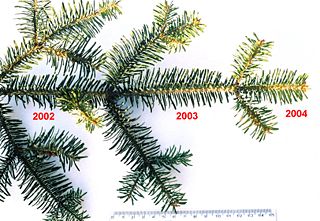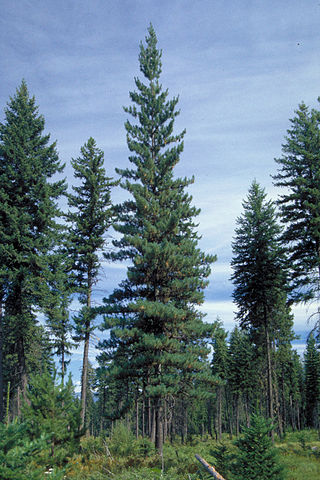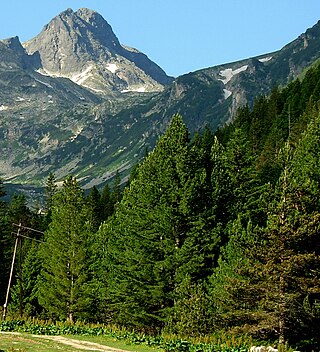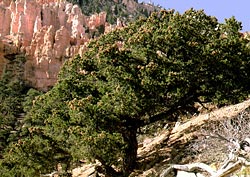
A pine is any conifer tree or shrub in the genus Pinus of the family Pinaceae. Pinus is the sole genus in the subfamily Pinoideae. World Flora Online, created by the Royal Botanic Gardens, Kew and Missouri Botanical Garden, accepts 187 species names of pines as current, together with more synonyms. The American Conifer Society (ACS) and the Royal Horticultural Society accept 121 species. Pines are commonly found in the Northern Hemisphere. Pine may also refer to the lumber derived from pine trees; it is one of the more extensively used types of lumber. The pine family is the largest conifer family and there are currently 818 named cultivars recognized by the ACS.

In botany, an evergreen is a plant which has foliage that remains green and functional through more than one growing season. This contrasts with deciduous plants, which completely lose their foliage during the winter or dry season.

Pinus albicaulis, known by the common names whitebark pine, white bark pine, white pine, pitch pine, scrub pine, and creeping pine, is a conifer tree native to the mountains of the western United States and Canada, specifically subalpine areas of the Sierra Nevada, Cascade Range, Pacific Coast Ranges, and Rocky Mountains. It shares the common name "creeping pine" with several other plants.

Western white pine, also called silver pine and California mountain pine, is a species of pine in the family Pinaceae. It occurs in mountain ranges of northwestern North America and is the state tree of Idaho.

Pinus peuce is a species of pine native to the mountains of North Macedonia, Bulgaria, Albania, Montenegro, Kosovo, the extreme southwest of Serbia, and the extreme north of Greece, growing typically at (600-) 1,000-2,200 (-2,300) m altitude. It often reaches the alpine tree line in this area. The mature size is up to 35–40 m height, and 1.5 m trunk diameter. However, the height of the tree diminishes strongly near the upper tree line and may even obtain shrub sizes.

Pinus flexilis, the limber pine, is a species of pine tree-the family Pinaceae that occurs in the mountains of the Western United States, Mexico, and Canada. It is also called Rocky Mountain white pine.

Pinus strobiformis, commonly known as southwestern white pine, Mexican white pine or Chihuahua white pine, is a medium-sized white pine tree whose native habitat is in southwestern United States and Mexico. It is typically a high-elevation pine growing mixed with other conifers.

Pinus strobus, commonly called the eastern white pine, northern white pine, white pine, Weymouth pine (British), and soft pine is a large pine native to eastern North America. It occurs from Newfoundland, Canada, west through the Great Lakes region to southeastern Manitoba and Minnesota, United States, and south along the Appalachian Mountains and upper Piedmont to northernmost Georgia and perhaps very rarely in some of the higher elevations in northeastern Alabama. It is considered rare in Indiana.

Pinus virginiana, the Virginia pine, scrub pine, Jersey pine, Possum pine, is a medium-sized tree, often found on poorer soils from Long Island in southern New York south through the Appalachian Mountains to western Tennessee and Alabama. The usual size range for this pine is 9–18 m, but can grow larger under optimum conditions. The trunk can be as large as 20 inches diameter. This tree prefers well-drained loam or clay, but will also grow on very poor, sandy soil, where it remains small and stunted. The typical life span is 65 to 90 years.

Pinus densiflora, also called the Japanese red pine, the Japanese pine, or Korean red pine, is a species of pine tree native to East Asia. In China it is known as 赤松.

Pinus cembra, also known as Swiss pine, Swiss stone pine or Arolla pine or Austrian stone pine or just stone pine, is a species of pine tree in the subgenus Strobus.

Pinus sibirica, or Siberian pine, in the family Pinaceae is a species of pine tree that occurs in Siberia from 58°E in the Ural Mountains east to 126°E in the Stanovoy Range in southern Sakha Republic, and from Igarka at 68°N in the lower Yenisei valley, south to 45°N in central Mongolia.

Pinus edulis, the Colorado pinyon, two-needle piñon, pinyon pine, or simply piñon, is a pine in the pinyon pine group whose ancestor was a member of the Madro-Tertiary Geoflora and is native to the United States.

Pinus ayacahuite, also called ayacahuite pine and Mexican white pine, is a species of pine native to the mountains of southern Mexico and western Central America, in the Sierra Madre del Sur mountains and the eastern end of the Eje Volcánico Transversal, between 14° and 21°N latitude in the Mexican states of Guerrero, Oaxaca, Puebla, Veracruz and Chiapas, and in Guatemala, El Salvador and Honduras. It grows on relatively moist areas with summer rainfalls, however specimens from its eastern and southern distribution live under really wet conditions; it needs full sun and well drained soils. Its temperature needs fluctuate between 19 and 10 °C on average a year. This tree accepts from subtropical to cool climate.

Pinus monophylla, the single-leaf pinyon, is a pine in the pinyon pine group, native to North America. The range is in southernmost Idaho, western Utah, Arizona, southwest New Mexico, Nevada, eastern and southern California and northern Baja California.

Pinus armandii, the Armand pine or Chinese white pine, is a species of pine native to China, occurring from southern Shanxi west to southern Gansu and south to Yunnan, with outlying populations in Anhui. It grows at altitudes of 2200–3000 m in Taiwan, and it also extends a short distance into northern Burma. In Chinese it is known as "Mount Hua pine" (华山松).

Pinus dalatensis, also known as Vietnamese white pine or Dalat pine, is a species of pine endemic to Indochina. In Vietnam it grows in the mountains of the central and south-central parts of the country at elevations of 1,400 to 2,300 metres. Only recently confirmed from Laos, the population located within the Nakai-Nam Theun Biodiversity Conservation Area is the largest, at the lowest elevation, and the northernmost of the known populations of P. dalatensis.

In plant morphology, thorns, spines, and prickles, and in general spinose structures, are hard, rigid extensions or modifications of leaves, roots, stems, or buds with sharp, stiff ends, and generally serve the same function: physically deterring animals from eating the plant material.
Both naturally and artificially occurring pine species (Pinus) can hybridize, combining their genetic material and sometimes creating hybrids that can be more or less vigorous than their parent species. An example of a naturally occurring hybrid pine is Pinus × sondereggeri, a naturally occurring cross between loblolly pine and longleaf pine. An example of the many artificial hybrids is Pinus lambertiana × P. armandii.



























